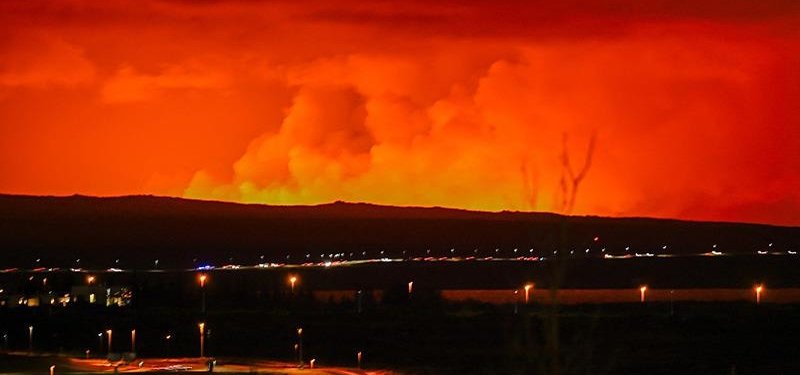
4th volcanic eruption in 3 months shakes Iceland's Reykjanes Peninsula
- World
- Anadolu Agency
- Published Date: 01:51 | 17 March 2024
- Modified Date: 01:51 | 17 March 2024
Residents in Iceland's coastal town of Grindavik saw their fourth volcanic eruption in the last three months, local media reported on Sunday.
Lava has flowed over the Grindavikurvegur, the road between the southwestern town and the rest of the Reykjanes Peninsula, according to public broadcaster RUV, which added that the eruption started at 8.23 p.m. (2023GMT) local time on Saturday.
The source of the current eruption is near an earlier one that occurred on Feb. 8, closer to the Stora-Skogfell mountain summit, it reported.
According to reports, the fissure is roughly 3.5 kilometers (2.17 miles) long, with lava flowing south towards the defensive wall north of Grindavik, west towards Grindavikurvegur, and to the east.
Grindavik and the nearby Blue Lagoon thermal baths were quickly evacuated, while the Keflavik Airport in the northwest and other regional airports were not impacted by the eruption and remain fully operational, added RUV.
The current eruption, closely monitored by the Icelandic Meteorological Office, is "the most powerful in the current system so far," it cited geophysicist Magnus Tumi Gudmundsson as saying.
"Right now, the situation is that we are primarily monitoring the progress of the lava flows. One flows southeast towards the sea, but it travels very slowly. We also monitor a tongue that travels west, north of Svartsengi," the RUV quoted the expert.
The report noted that the defensive walls appeared to be holding back the lava flow and directing it towards the sea, while another flow north of the walls was approaching a heating supply line but that there was still some distance to it.
The heating line is about 250 meters away (over 820 feet) from the lava flow, which is traveling slowly to the west, it said, adding that the flows had become less active and slowed down.
"If the activity does not decrease further and the lava flow stops, it should reach the line in the next few hours," said Einar Hjorleifsson, a natural disaster expert at the Icelandic Meteorological Office, told RUV radio news as he reviewed the situation as of 7 a.m. local time.
Hjorleifsson said the "gas that can come from the eruption is also being monitored."
"We have been measuring sulphur pollution on our meters in Grindavik and we continue to monitor it today. Responders have gas meters and gas masks. It has crossed the threshold of discomfort in many places tonight," he said.
The RUV said gas may be noticeable in Keflavik and Reykjanes later in the day, while the Meteorological Office is expected to hold a meeting at 10 a.m. with responders, followed by a news update on the eruption.
- Putin thanks Russians for voting, troops fighting in Ukraine
- EU pledges $8B funding package, upgraded relationship with Egypt: President al-Sisi
- Any forced displacement of Palestinians into Egypt ‘unacceptable,’ Greek premier says
- German chancellor calls for 2-state solution to Israel-Palestine conflict
- Putin leads with 87% in Russian presidential election: Exit poll

